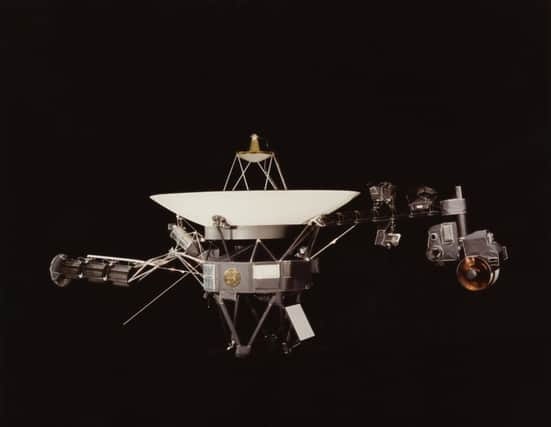Alex Massie: Existential moment as we gaze at stars


Easter brings to mind TS Eliot’s lines from the Four Quartets, “We shall not cease from exploration/and the end of all our exploring/will be to arrive where we started/and know the place for the first time”.
A capacity for wonder may be the most human quality of all. Without it we are reduced in scale and spirit.
Advertisement
Hide AdAdvertisement
Hide AdFar from being, as David Cameron rather oddly put it in an article for Premier Christianity, “all about remembering the importance of change, responsibility, and doing the right thing for the good of our children”, Easter is a brutal festival.
Christ died on a cross for our sins, not his. It remains a shocking proposition and it has never struck me as necessary to believe in the reality of this sacrifice to appreciate that the mere idea of it is as shattering as it is sobering. And humbling too. It is, literally, awesome.
Easter, then, much more than Christmas or other Christian festivals, puts us in our place and, as I say, I do not think you need be a true believer to appreciate the power of that idea.
It stirs the imagination even as it may chill your soul. That’s the power of wonder.
I thought of this the other day when I was reading about the latest adventures of the Voyager probes sent deep into space nearly 40 years ago. These brave little explorers – it is impossible to avoid anthropomorphising the Voyagers – have the power to humble us even as they enthral us.
Like Christ, if you will forgive this mild blasphemy, they nudge the boundaries of the human imagination. The distances they have covered in their ceaseless trek across the solar system are beyond ordinary comprehension.
Each day Voyager 1 moves another million miles further into space.
This emissary from planet earth has traveled 12 billion miles already and though Voyager’s primary mission ended 35 years ago when our gallant explorer visited and chronicled Jupiter and Saturn, on she goes. There is no recall mechanism.
Advertisement
Hide AdAdvertisement
Hide AdVoyager and her twin fly on, albeit with ever-diminishing reserves of power. Most of their sensors have already been switched off, the better to preserve the Voyagers’ batteries. The last of the five still-working instruments will die sometime in 2025 after which point Voyager will no longer hear from us or speak to us. There is something melancholy about that thought.
It will be a kind of death even if Voyager will still drift on through space forever. Eventually, Nasa say, the Voyagers will pass other stars. For instance, in about 296,000 thousand years Voyager 2 will pass 4.3 light years – or 25 trillion miles – from Sirius, the brightest star in our sky. The mind boggles.
Which is why I think the Voyager mission is one of the grandest things our species has ever done.
These little probes, each weighing less than 900 kilograms, are witnesses to, and the products of, the spirit and imagination of our people. Chasing the stars is a wondrous thing, one of the most amazing adventures in human history. It expands our sense of the possible even as it reminds us of our utter insignificance in the vastness of interstellar space. It is something to be cherished.
So it has been an adventure every bit as great as the mythic fables of ancient Greece or the epic Viking sagas. A modern day quest for the Golden Fleece; a reminder of who we are and where we have come from. Planet Earth, reaching out to whatever lies beyond the great beyond.
Only ossified souls can fail to be moved by this. It does not matter if there is nothing there or that Voyager will soon no longer be able to tell us stories of its adventures. What matters is the dream itself. It is sad, then, that mankind has largely turned away from the epic romance of space exploration. The limits of our ambition these days are not quite confined to the International Space Station, a mere 250 miles above the earth but, with the plausible exception of the Mars rover, nor do we seek to push the boundaries of our imagination as once we did. It is a curiously unsettling diminishment. Perhaps some dreams really do die.
If, as the great Texas country singer Townes van Zandt once sang, “To live is to fly/Low and high” then so it is time, as the song goes, to “shake the dust off of your wings/and the sleep out of your eyes”.
The genius of the Voyager missions was the manner in which, by exploring the far reaches of space, they prompted us to look anew at ourselves from the vantage point of that distant beyond. No dust; no sleep.
Advertisement
Hide AdAdvertisement
Hide AdThese tiny space craft have made us wonder. It has been a thrilling adventure.
And even though the messages take longer and longer to reach us and grow fainter by the day, the adventure continues. In some sense it may never end. As Nasa says, “The Voyagers are destined – perhaps eternally – to wander the Milky Way”. What could be more beautiful – and more beautifully haunting – than that?
Our planet, Carl Sagan said, “is a lonely speck in the great enveloping cosmos dark” – a thought that’s both terrifying and yet also curiously reassuring.
Such are the paradoxes of wonder. And of life itself.
FOLLOW US
SCOTSMAN TABLET AND MOBILE APPS